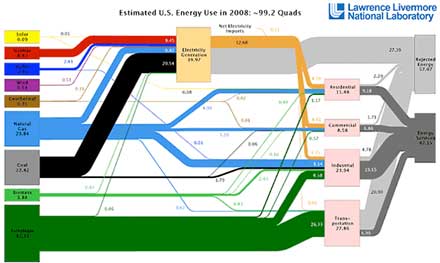A rendering of energy flows in the United States in 2008. Lawrence Livermore Labs updates one of these each year.
Amazing and informative:
- The two strong correlations: oil-transportation, and coal-electricity.
- The huge amount of energy “rejected” due to transmission line loss, waste heat from light bulbs and power plants, inefficient vehicles, and so forth.
- The micro contribution of renewable sources.
From the Department of Who Knew:
- It’s called a Sankey diagram. Tufte made famous this Sankey flow chart drawn in 1869 by Charles Minard showing Napoleon’s disastrous march into Russia.
- Sankey diagrams have websites. Here’s one.
- One quad is equal to 8,007,000,000 gallons of gasoline, 36,000,000 tons of coal, or 252,000,000 tons of TNT.
Designing the world from scratch, what would your version of the energy flows look like?

Comments
More on the “rejected energy” bit:
Efficient is good.